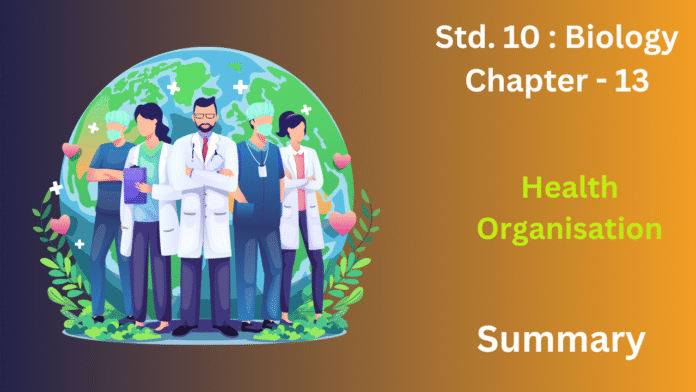This chapter focuses on the various organizations, both international and national, that work to protect and improve public health.
1. The World Health Organization (WHO)
What it is: A specialized agency of the United Nations (UNO) that acts as the directing and coordinating authority on international health.
Headquarters: Geneva, Switzerland.
Objective: To attain the highest possible level of health for all people.
Main Functions:
Global Health Leader: It provides leadership on global health matters and sets norms an standards.
Research: It promotes medical and scientific research to find cures for diseases.
Disease Control: It works to prevent and control epidemic and endemic diseases (e.g., malaria, AIDS, COVID-19).
Drug Safety: It lays down pharmaceutical standards for the safety and efficacy of drugs.
Health Services: It helps countries strengthen their public health services and training of health workers.
Vaccination: It runs global immunization programmes.
Quarantine Measures: It suggests quarantine measures to prevent the international spread of diseases.
2. The Red Cross
What it is: A non-political, non-official, voluntary international relief organization.
Motto: “Service to Mankind in Peace and War.”
Founder: Jean Henry Dunant.
Red Cross Day: Celebrated on May 8th (Henry Dunant’s birthday).
Main Functions / Activities:
Disaster Relief: Provides first aid, medicine, food, and clothing to victims of natural disasters (floods, earthquakes) and man-made disasters like war.
Blood Banks: It manages and supplies blood for transfusion through blood banks.
Ambulance Service: It provides ambulance services in emergencies.
Tracing Service: It helps trace missing family members during wars or disasters.
Community Health: It runs maternity and child welfare centers.
Training: It provides training in First Aid, Home Nursing, and other basic medical services.
3. Other Important Bodies & Concepts
Local Bodies (Municipalities): They are responsible for public health at the city level. Their duties include:
Supply of safe drinking water.
Proper disposal of sewage and garbage.
Checking food adulteration.
Controlling insects like mosquitoes and flies.
Maintaining dispensaries and hospitals.
Common Health Problems in India: The chapter highlights issues like malaria, typhoid, tuberculosis, and AIDS, often linked to poverty, poor sanitation, and lack of clean water.
Key Reasons for Formation of such Organizations:
To have a central, global body (like WHO) to coordinate health efforts across countries.To provide a neutral, humanitarian service (like Red Cross) for relief during wars and peacetime.To combat health problems that are not confined to one country and require international cooperation.In short, this chapter teaches us that maintaining global health is a shared responsibility, and organizations like WHO and the Red Cross play a vital role in fulfilling this duty.
A. MULTIPLE CHOICE TYPE
(Choose the most appropriate option in each case)
1) Red Cross Day is celebrated on:
(a) May 21
(b) June 23
(c) September 17
(d) November 21
Ans: (a) May 21
2)WHO headquarters are located in:
(a) Paris
(b) Berlin
(c) Geneva
(d) New York
Ans:(c) Geneva
B. VERY SHORT ANSWER TYPE
1) Name the organization responsible for the following:
(i) To extend aid to victims of amphibian illness
(ii) To lay pharmaceutical standards for important drugs
(iii) Ambulance in emergencies
(iv) To suggest quarantine measures
(v) Tracing of relatives
(vi) Focusing and supplying blood for transfusion
Ans:
(i) To extend aid to victims of epidemic illness
Ans: The Red Cross.
(ii) To lay pharmaceutical standards for important drugs
Ans: The World Health Organization (WHO).
(iii) Ambulance in emergencies
Ans: The Red Cross.
(iv) To suggest quarantine measures
Ans: The World Health Organization (WHO).
(v) Tracing of relatives
Ans: The Red Cross.
(vi) Focusing and supplying blood for transfusion
Ans: The Red Cross.
2)Name any two habitation-based health problems.
Ans: Two examples of habitation-based health problems are:
- Respiratory infections caused by poor indoor air quality due to overcrowding and lack of proper ventilation.
- Vector-borne diseases like dengue and malaria, which spread easily in areas with stagnant water and poor waste management.
3)What do the following abbreviations stand for?
(a) WHO
(b) UNO
Ans:(a) WHO stands for the World Health Organization.
(b) UNO stands for the United Nations Organization.
4)Mention if the diseases listed below are correctly matched (Yes or False). Write the correct alternative for the wrongly matched.
| Disease | Agent | T/F | Correct alternative, if wrong |
| MalariaTyphoidCholeraTuberculosisWhooping coughPneumoniaDengue fever | Housefly Housefly Droplets Mosquito Air borne Houseflies Rat flies |
Ans:
| Disease | Agent | T/F | Correct alternative, if wrong |
| MalariaTyphoidCholeraTuberculosisWhooping coughPneumoniaDengue fever | Housefly Housefly Droplets Mosquito Air borne Houseflies Rat flies | F F F F F F F | Protozoan (Plasmodium) Protozoan (Plasmodium)Bacteria (Vibrio cholerae)Bacteria (Mycobacterium tuberculosis)Bacteria (Bordetella pertussis)Bacteria/Virus (e.g., Streptococcus pneumoniae)Virus (Dengue virus) |
C. SHORT ANSWER TYPE
1)Mention two responsibilities of City Municipalities in caring for public health.
2)List any two health problems in India.
3)State the functions of WHO.
4)State the main functions of Red Cross.
5)State the main functions of World Health Organization.
6)List four major activities of the Red Cross.
Ans:
1) Mention two responsibilities of City Municipalities in caring for public health.
Solid Waste Management: Ensuring the regular collection, scientific disposal, and management of garbage and sewage to prevent the spread of diseases.
Public Sanitation and Water Supply: Maintaining clean public areas, providing safe and potable drinking water, and controlling mosquitoes and other pests.
2) List any two health problems in India.
Communicable Diseases: Such as Tuberculosis, Malaria, and Dengue, which spread from person to person.
Malnutrition: A condition arising from the lack of proper nutrients, which affects a large number of children and adults.
3) State the functions of WHO.
The World Health Organization (WHO) acts as the directing and coordinating authority on international health. Its key functions include fighting diseases, improving nutrition and maternal/child health, and setting global standards for food and medicine safety.
4) State the main functions of Red Cross.
The main function of the Red Cross is to provide relief and help during emergencies and disasters, without any discrimination. This includes offering medical care, food, and other aid to victims of war and natural calamities.
5) State the main functions of World Health Organization.
(Note: This is the same as question 3. The functions of WHO are:)
To prevent and control specific diseases.
To develop and improve public health services and family health.
To assure the quality and safety of medicines and vaccines.
6) List four major activities of the Red Cross.
Providing first aid, ambulance services, and blood for transfusion.
Offering relief during disasters like floods and earthquakes.
Helping to find missing family members, especially during conflicts.
Promoting health and hygiene awareness in communities.
D. LONG ANSWER TYPE
Describe the reasons for the formation of WHO.
Ans: The World Health Organization (WHO) was formed in 1948 for several key reasons, primarily emerging after the Second World War.
The main reasons were:
- To Create a Global Health Body: After the failure of the League of Nations and its health organization, there was a strong need for a single, powerful international agency dedicated to health, operating under the newly formed United Nations.
- To Coordinate Global Efforts: Before WHO, different countries had different health policies and there was no central coordination. WHO was created to unify global health strategies and ensure all nations could work together against diseases.
- To Fight Epidemics and Pandemics: History showed that diseases like cholera, plague, and smallpox do not respect national borders. The founders recognized that a collective international effort was essential to monitor, control, and prevent the spread of such diseases across the world.
- To Improve Poor Health Conditions Globally: The war had left many countries with shattered health systems. There was a urgent need to rebuild and strengthen public health services, especially in poorer nations, and to define “health” as a state of complete physical, mental, and social well-being, not just the absence of disease.


